|
|
|
|
Chapter
6
Ludham Boatyards
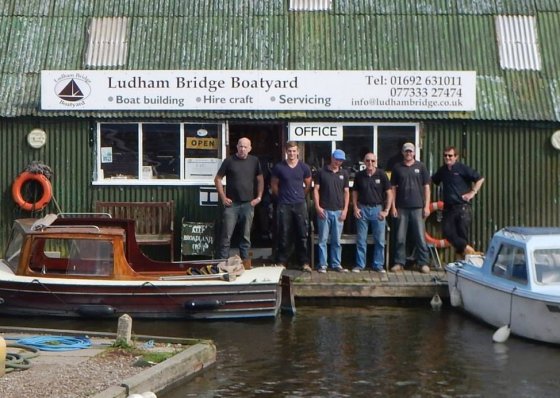
|
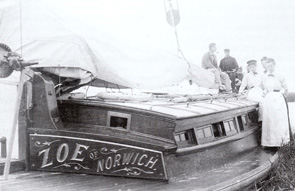
|
Little is known about boat
builders or boat building in Ludham at the
beginning of the Twentieth Century, although it is
known that the Trading Wherry Zoe had been built
at an open workshop (Malster 1971), part of the
farm owned by Robert Harrison, for Riches of
Catfield. From this it could be deduced that some
small-scale work had always featured along the
banks of the dyke. |
The Harrison family moved to the
United States of America in 1904 and the owner of
the farm is unknown until 1924 when the Hurkett
family took up residence. A bungalow was built on
the site of the boatshed and was advertised for
let in the 1924 edition of the Blake’s catalogue.
The pigsty was remodelled into another small
bungalow for let and at some time afterwards a
boatshed was erected next to the slipway. In the
1930’s the farm and the two main dwelling houses
were split up, and the latter were bought by
Millicent Beadnell. After the Second World War, in
July 1947, they were sold to the Gabriel family.
|
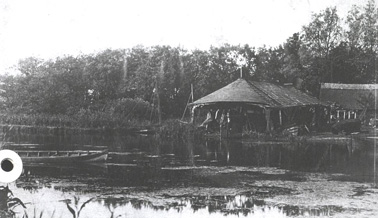
|
The boatyard, the two bungalows, one still occupied and
named Misty Morn, were purchased by the Gollings family,
with the boatyard being run by Jimmy Gedge and known as
Womack Boats. The Gollings ran a shop from the rear of one
of the bungalows and small boats were let out by the day
or week. A small pleasure wherry with a counter stern,
called Broadsland by the boatyard, but believed to have
been the Goldfinch was moored in the dyke. This was burnt
down to the waterline and its remains were concreted over.
Broadsland was used as a houseboat alongside two others,
the Delta, based on a yacht hull and the Grace. The motor
cruisers, Fleetwing (4 berth), Toby (2-3 berth), Golden
Sunset (3 berth) and Alytra (6 berth) were also available
for hire as were a number of day boats.
Womack Cruisers
In 1978 Vaughan Ashby took over the yard. It was re-named
Womack Cruisers. General boatyard work was undertaken and
a fleet of ten boats were available for weekly lettings.
The boats were named after characters from the Arthurian
legends; Sir Lancelot, Sir Bedivere, Sir Garnet, Sir
Tristan, Sir Galahad, Sir Camelot, Sir Percival & Lady
Guinevere. The remaining two boats are unidentified.
During this time the shop was closed down. In 1979 the
Norfolk Wherry Trust over-wintered Albion at this site
until she took up moorings further down the dyke. In1983
the yard closed, and the workshop and one bungalow were
demolished whilst Misty Morn remained. In February 1984
planning permission was sought for a change of use for the
site from that of boatyard to that of residential use;
this was granted and two private houses were built.
Reg Buck, a boat builder from Wroxham, worked in the
village for a short time in one of the redundant buildings
that remained on the Ludham Airfield site, near the
junction of Latchmore Lane and Grange Road. A year before
his retirement he was completing a three-quarter size reed
lighter for the Cator Estate. It was made of oak, was
nineteen feet in length and with a beam of six feet six
inches. Mr Buck had selected the timber at Lingwood three
years earlier in 1971. The lighter was fastened with
copper nails and brass screws. Reg Buck was also
responsible for constructing a launch for William Mervyn,
a character actor who lived in Ludham at the time.
At the north end of Womack Water adjacent to Horsefen
Road, was a small boat house at the side of the north
dyke. It had been run in a small way by a number of owners
doing minor repair work and a few boat sales. After the
Second World War it was run for a time by Alec Snelling
and also by Catlow and Brinded, in the later case it was
used for outboard motor maintenance until 1979 when the
business moved to the Blacksmith Shop in School Road.
Whilst at Womack they also used the old fire station at
the junction of Yarmouth Road and Latchmore Lane, as a
store and for G.R.P. work and after relocation to the
Blacksmith Shop kept it on as a store for some time. In
1983 Mike Fuller used the old fire station for boat
maintenance until his retirement in 1995.
The building occupied by Catlow & Gilding at Womack
Water was sold to Tom Murray in 1979 who operated a fleet
of hire boats from it. In 1985 the site was developed to
provide retail premises, several flats for letting
purposes, a wet boatshed, and moorings with pump-out
facilities and a fuelling point. Boat sales and boat lets
were undertaken. In recent years a number of tenants
managed parts of the business.
Ludham Bridge Boatyard
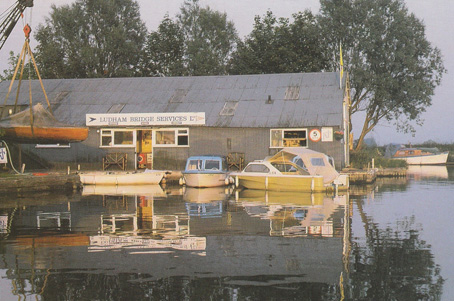
|
Whilst much of the boatyard
activity was centred along Womack Water there had
been a boatyard at Ludham Bridge before the
beginning of the Second World War. During that
period H.T. Percival from Horning was operating
from the site (just to the south of Ludham
Bridge), but little has been recorded about his
activities there and no firm dates can be given.
At some stage after the War, Peter Brandish owned
the business, but being an active musician, left
it to a manager to run. At that time it was known
as Ludham Bridge Boatyard. Robert Paul took over
the yard in 1967 when it was renamed Ludham Bridge
Services Ltd. The business started with three
motor cruisers that were on hire through Hoseasons
called Nice'n Easy, Bright'n Easy and Free'n Easy,
and about six motor launches. After several years
the cruisers were sold and the business
concentrated on the dayboats supplemented with
boat maintenance and boat building. Slowly the
number of staff was increased until 2000 when five
were employed in the yard. The land was leased
from the Environment Agency from whom an
additional amount was rented to enable expansion
to occur.
|
The Norfolk Wherry Trust
| In 1981 The Norfolk Wherry Trust
came to Ludham and took up rented accommodation on
land off Womack Water owned by Norfolk County
Council and previously by the Hunter family. Work
began in August 1981 when a dyke was dredged and
quay heading erected. Within four years the Trust
had purchased the dyke and a small amount of land
extending to 0.65 of an acre with access to
Horsefen Road for £5000 and had, after three years
a permanent base for the (then) last remaining
example of the trading wherry. |
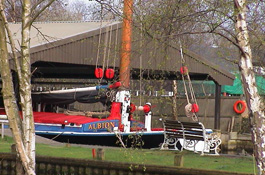
|
In 1985 the dyke began to be developed to provide quay
heading on both sides and was officially opened on 23rd
September 1988 by Humphrey Boardman. A major capital
investment followed to provide a covered wet shed to
protect Albion from the elements and to provide some
undercover facilities for winter maintenance.
Since establishing itself at Ludham the Norfolk Wherry
Trust has developed its site to include a work shed, the
original of which, brought second-hand from Neatishead in
the extremely cold winter of 1985-1986, regularly flooded
during the winter, making conditions for working quite
unpleasant until 1999, when a new shed, set on piles was
erected and working conditions took a major leap forward.
Sid Chettleburgh became bosun, in charge of maintenance in
1984 and was assisted by Mike Fuller. He left this
position in 1992, with Mike Fuller continuing until 1999
with assistance from a small group of volunteers. Most
maintenance jobs can be accomplished at this site, but
there is no heavy lifting equipment to remove the mast nor
is there a slipway, despite the possibility of erecting
one being a recurring theme within the Trust. Without
these resources Albion regularly has to make visits to
slipways in Wroxham, Horning and Lake Lothing for major
work.
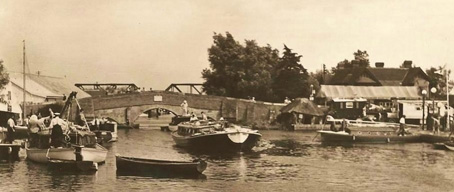
|
In 1970 the Lord Roberts was given
to the Trust by May Gurney, at the end of her
commercial life. Although at that time she still
retained her mast, she had for many years been
operated under power. She had been built at
Somerton by Ben Benns for the Thain family of
wherry operators. She lay for a number of years in
a side dyke at Hunter’s yard awaiting the finance
to restore her to be the centre-piece in a
proposed Broadland museum. On one occasion she
sank on her moorings and was re-floated as
practice by the local fire brigade. Eventually she
was moved to a dyke in Hoveton where she probably
still lays. |
Ludham Marine
Brenda and John Kelsey managed
the yard formerly occupied by Catlow & Gilding
from January 1994 until December 2000, trading as
Ludham Marine. They ran a hire business with
fifteen cruisers of various lengths, ranging from
27 feet to 41 feet, and marketed through the
Blakes Organisation. In addition several day boats
and rowing and sailing dinghies were available.
|
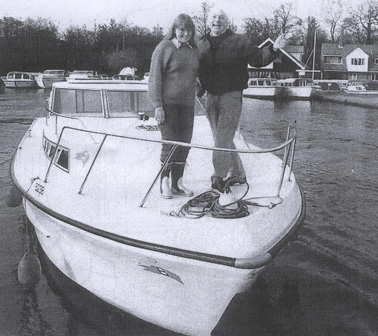
|
John and Brenda write about the problems and joys of
operating a small family-run boat hire business:
“The summer season was always immense fun, but could
equally be frenetic. The logistics of ‘turning around’ the
boats ruled our lives. Clean bedding was returned to us
from the laundry on Thursdays. This then had to be checked
and sorted into bags for each individual cruiser. Bedding
lists were unique for each holiday, dependent upon the
number of people booked onto the boat, the configuration
required (double or single bunks) and how long the holiday
was due to last, as each additional week needed extra
bedding. Brenda spent many happy hours in the linen shed
with any boredom alleviated by the seeking-out of missing
items, which might be either at another boatyard, or still
at the laundry.
Boats were ‘turned round’ usually on Friday, Saturday and
Monday. After the departing holiday-makers left the yard
we had a maximum of seven hours to get, maybe nine boats
ready for the next parties. Sounds easy enough! Clean the
boat, inside and out, service her, refuel her, make the
beds and get her away. Logistical problems abounded,
including the following; a boat returns late for a variety
of reasons. It rains, making it such fun getting on and
off the boat with clean bedding, making it difficult to
keep the interior clean. Engineers work on board, making
it impossible not to leave dirty footmarks on cleaned
decks. The discovery of mechanical problems not reported
whilst out cruising, such as broken windows, pumps,
lights, or anything you can think of, as well as blocked
toilets! Staff absence or problems on ‘turn round’ days
magnified problems enormously.
We asked holidaymakers to advise us of their approximate
time of arrival back at the yard at the end of their
holiday, and we would try to plan our work on the cruisers
to suit. It might be Murphy’s Law, but quite often the
first to arrive would be the ones who had not given a time
of arrival, or whose boat had been delayed because of
problems and the last to arrive might sometimes come on
the following day. Greeting our guests was always fun.
Sometimes they were old friends who had been with us
before, often children bursting with excitement and hardly
able to wait to discover if Arthur Ransome had been right
about the Broads. There was always that wonderful sense of
anticipation of going on a voyage, whether they were going
as skipper or as crew.
There is no slipway at the yard, so hull repairs were a
problem. In the depth of winter, but quite often on a day
bright and sunny enough to journey with the hood down, we
would move cruisers to other yards at Potter Heigham,
Stalham, Acle or Wayford Bridge to have them taken out of
the water so we could spend hours, usually outside,
repairing and painting hulls.
We gave up the yard for a variety of reasons, principally,
increased legislation. This put an additional and unfair
expense on small businesses. The most significant problem
was the lack of decisiveness. For example, on one December
day the Weights and Measures Inspectors confirmed that our
imperial fuel pumps were accurate, then early in the
following year advised us that they must be replaced with
metric gauges, and this at no small cost. All cruisers
were fitted with fire extinguishers (inspected annually),
but then rules changed and different types were required.
In the end this took the joy out of the job.”
Hunter’s Yard
Percy Hunter and his sons, Stanley and Cyril, initially
worked at Applegate’s Yard at Potter Heigham. In 1931
Percy bought a parcel of land off Womack Dyke to establish
his own business. On completion of the sale in 1932 a dyke
was dug that was 250 feet long by 30 feet wide to link the
boat shed site to the Dyke. Lullaby and Lustre were built
on site and Pegg’s of Wroxham built Woodruff. This was the
formation of the fleet that were in hire through Blake’s
by the next year.
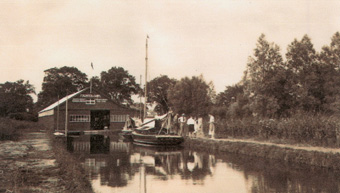
|
For the next few years an
extensive building programme was in place to build
up the fleet (see end of chapter). By the outbreak
of the Second World War thirteen boats had been
built at the yard. The yard was closed for the
duration of hostilities and Cyril and Stanley
worked away from Ludham, first on the Thames,
building Motor Torpedo Boats (Johnstone-Bryden,
2004) and then returning to Norfolk to work at
Potter Heigham at Herbert Woods’ yard. |
In 1944 the yard re-opened with blackout precautions in
place (Johnstone-Bryden, 2004) and in 1947 Tom Grapes
began to work there. Two more of the Wood Class were built
to complete the fleet and business returned to normal. On
26th January 1964 Percy Hunter died and on 1st January
1968 the yard was sold to Norfolk County Council for
£35,000 and became the Norfolk County Sailing Base.
Stanley Hunter retired and Les Gee became Fleet Warden.
In 1970 Jim Searle became Fleet Warden and Graham Cooper
joined the team as boat builder. The fleet formed the
basis of the Education Department’s Outdoor Activity
programme for sail cruising and became an important
introduction to sailing for many schoolchildren from
Norfolk and beyond. The experience of Broads cruising with
the Hunter Fleet has established for many people a
continued love of sailing and broadland.
In 1974 Cyril Hunter retired and
direct family involvement was lost. Ian Grapes
joined the team in 1981 and in 1983 Lullaby became
Teasel in the BBC Television series called
“Swallows and Amazons For Ever”, based on Coot
Club and The Big Six by Arthur Ransome. The Wherry
Albion became Sir Garnet.
"Tom Grapes retired in October 1994 after 47 years
at the yard. Norfolk County Council was finding it
increasingly difficult to justify the expenditure
on outdoor activity centres and in 1995, Jim
Searle retired and the yard and fleet were put up
for sale. An emergency steering group ran the
fleet during the year and following much publicity
the Norfolk Heritage Fleet Trust was formed on 1st
April 1996, financed by both public support and
lottery fund grants.
In 1999 Rebel Reveller was donated to the Trust
and joined the fleet sixty-seven years after its
foundation. |
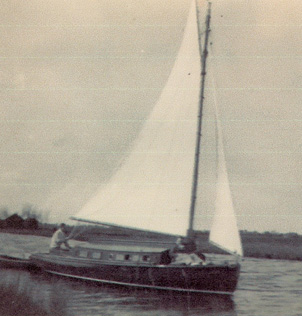
|
Graham Cooper of Hunter Fleet
Graham Cooper started at Hunter’s Yard in June 1970, two
years after the NCC had acquired it, in response to a
small advert in the Eastern Daily Press for a boat
builder. Those working there at the time were Tom Grapes,
Roger Nudd, Josie Webb (the office administrator), Jim
Searle (the fleet warden), and Cyril Hunter who acted as
part-time consultant. Cyril was doing the woodwork but as
he was nearing retirement age it was realised that they
needed someone to work full time.
Graham had started at Martham Ferry boatyard by completing
a five-year boatbuilding apprenticeship. He said that
there were not many opportunities at that time to work
with wood, as opposed to GRP, nor to work with yachts.
Graham describes his main functions as being “a boat
builder and repairer, who co-ordinates the maintenance of
the hire fleet boats and promotes the smooth running of
activities in the workshop and on the practical side of
the business.” He says that work at the yard is routine
with one season rolling into another. The bulk of the work
is varnishing and rigging. Whilst Tom Grapes was the only
member of the team to do the sign writing, they can all
turn their hand to anything from making burgees to reef
ties.
Graham and the team would decide what needed to be done to
the boats, and when Jim Searle was fleet warden he would
rubber-stamp their decisions. Graham ran things past Bryan
Read, Chairman of the Heritage Fleet Trust, and then
organised the budget accordingly – not with extra funding
but by allocation. For example they had a rough budget for
awnings, expecting to replace on average three a year, for
sail replacement and repair, and so on. A suit of sails
was expected to last between seven and ten years. Most
sails were made by Jeckells of Wroxham but once Paul
Newell, an acquaintance of Jim Searle from the Isle of
Wight, made a suit to try out. These were heavy and not
very user friendly or easy to handle. Graham said that
they were prepared to use new materials as the need arose
and as long as they were in keeping with the boats. For
example when deck lino needed replacing they tried a new
flooring material which was used in showers. It may have
lasted longer, but was also found to be a bit to
slippery. So, some yachts had the new domestic
flooring installed, but the next time it required
replacement they reverted to lino.
There have been the ups and downs over the years. For
example the County Council resourcing was seldom
consistent, particularly in budgetary provision, making
forward planning difficult. When budgets were restricted
there might be a squeeze on sail replacement, and
sometimes staffing levels were not adequate. When Tom
retired he was not replaced so that left just Ian and
Graham managing between the two of them. That meant they
had to cut corners and they were not happy with the
situation. It was a great help that Tom came back on a
part time basis and a relief when the Trust took over as
it had become a bit of a losing battle with the council.
Graham’s worst time at the yard really was during the
uncertainty about the take over and funding, although the
staff in general had an open mind as to who should take
over and what the consequences might be. As it turned out
the Trust has not only improved the working environment
but also enabled the yard to continue in a traditional
way.
One of the most interesting
times was when the BBC filmed Swallows and
Amazons. They hired Lullaby for three months.
In spite of the boats being more or less as they
were originally the men had to give the sails
a“1930’s” look. Egyptian cotton was the material
used in the 1930s but was unavailable, so a cotton
look-alike, Duradon, was used. It was made by sail
makers at Yarmouth Stores in the traditional style
with rope edging, but was so heavy in use that not
only did it not look good but it also bent the
gaff.
The yard staff would work in the daytime as normal
and then in the evening would shunt the boats
about for the film crew, for example from Hickling
to Barton, using outboard motors. When they went
to Breydon for the scene where the Margoletta rams
Teasel it was a blazing hot summer day and they
needed to make fog for those scenes! |

|
One nice thing is getting to know repeat customers. Over
the years they can become good friends. Many people
re-book the most popular weeks before they go home,
especially on the 4 berth boats. Regular hirers like to
keep their slot and are given first refusal.
Boats are in the water from Easter to early October. This
strikes a balance between not leaving the boats drying out
in the shed for too long and having time to do the winter
maintenance. Graham has often considered the possibility
of extending the season. Big groups such as Scouts
sometimes have to compromise and come a week earlier at
Easter, and lots of customers prefer to come in the
earlier part of the year when there are better winds and
fewer leaves on the trees. They once tried to extend in
the autumn by keeping half the fleet in until the October
half term but the weather is a problem at that time. Heavy
dew and cooler temperatures mean the covers are put away
wet in the hatches and will still be wet when put on the
next evening, so beginning to go mouldy and deteriorate.
Maintenance then becomes more difficult. Also at that time
of year weekend bookings are more likely, but as the boats
need just as much work at change round time as a weekly
booking it makes hiring less worthwhile.
Hauling boats out is a team effort using a traditional
method, which the men have honed to a fine art. The only
concession to modern technology is the use of an electric
winch with a dead man’s handle, where before they used a
hand winch from a wherry. The key or trick is to fit the
keel into a greased channel. They have a keel guide
that someone pushes either side of the keel while the boat
is in the water. The guide slopes from eighteen inches
high at the stern to just a few inches near the bow. A
greased way is placed low down on the slipway, lined up
with the guide. A plank sits in the channel level with the
top of the channel edges. The boat is hauled with ropes
until the plank is under the keel. One man leaning against
one side supports the boat and they place wooden ‘stools’
(trestles and crates) every six feet just in case she tips
too much. The plank slides with the boat along the channel
as the men move the boat on the greased ways through the
sheds. They can change direction by positioning the next
greased way at an angle. Once in their correct position
the boats are lifted with levers (men with wood) onto
‘stools’ either side and propped at the stem and stern.
There have been some strange events involving the boats.
Most incidents relate to the half-deckers. Sundew was sunk
on Hickling by hooking the mainsheet on a navigation post
when going at a fair pace. The boat was pulled over and
she filled up. The force of the impact pulled the
tabernacle out and the mast shot through the bottom of the
boat and she sank. Graham and Tom and their families went
to rescue her in Lullaby. They got the mast out and raised
Sundew with a lever at each end. Once she was just below
the surface they used the awning to cover the hole and
pumped with the yard’s old fire pump. They put everything
back inside and towed her back under outboard.
When Brown Bess was sunk on the dolphins on Breydon, at
the edge of the channel, they waited till low tide before
re-floating her. The bilge was full of little crabs, no
more than an inch across, in the limber holes and
everywhere. Graham says, “More often than not when a boat
sinks it’s a case of wading in, finding the hole and
filling it. It’s always a challenge, but we’ve never yet
been stumped on how to retrieve a boat, you’ve got to!
There’s 5 cwt. of lead on the smaller boats so that’s not
a dead weight and they semi-float even when they’re full
of water.” If a yacht is sunk in deep water the men will
drag it into shallower water near the shore before
attempting to raise her.
Twenty years ago when Lullaby lost her keel bolts at St
Benet’s the helm at the time said that she suddenly
wouldn’t steer, but just blew sideways. The bolts had
rusted through and the ballast keel fell off. Joe Charlton
was working at the yard and his father Peter was in the
police diving team. They were volunteered to rescue it as
an exercise. They borrowed a fibreglass dory from Filby
(Sailing Base) and managed to lug the 8cwt of lead out of
the water. Since that time there has been a programme of
replacement. When hauling out, if a bit of movement is
seen it is taken as a warning.
In addition to their own fleet the yard has catered for
private customers by providing building, over wintering,
and summer mooring services.
Graham feels that the yard has no need to diversify or
change radically in the near future even though the hire
boat business is going through a period of change. Sailing
yachts have different issues and the decline of the motor
cruisers on the Broads may be a benefit from the sailing
point of view in some ways, but not if the support
services such as toilets and viable pubs decline too.
An Outline History Of Hunter’s
Yard: 1900-2000
Percy Hunter and his sons, Stanley and Cyril, initially
worked at Applegates Yard, Potter Heigham. They gradually
established from scratch their own profitable family
business, “Hunter’s Yard “ at Womack, which they ran from
the early 1930’s to the mid-1960’s.
Timescale
1931
Charles Green agreed to sell the land
to Percy Hunter for £200.
1932
6th February purchase completed, 30’ wide dyke dug 250’
long, by hand,
to link the shed site to
the river.
Lullaby and Lustre built,
for hire through Blake’s, (with 11’ rowing/sailing tender)
Woodruff built
at Pegg’s, Wroxham.
1933
Planning permission for first shed to be built .
Luna, Wood
Sorrel and Woodcut (half-decker) built.
1934
Wood Violet built.
1935
Wood Rose built, second shed built.
1936
Hustler, Hustler 2 built.
1937/8 Hustler
3, Hustler 4 built.
1938
Woodcut 2 built.
1939
Hustler 5 built.
August
boats slipped, sheds camouflaged, yard closed.
Cyril and Stanley worked
on MTB’s on the Thames for a few months, then joined
Percy at Herbert Woods’, Potter Heigham for
the rest of the war.
1944
Yard re-opened, blackouts at windows
and green canvas on cabins.
Wood Avens or Wood Anenome
built. (cast iron keel - war shortages).
Tom Grapes
started 1st March.
1949
Wood Anemone or Wood Avens built.
1952
Onwards, cotton sails were replaced
with Terylene, manila and hemp ropes were replaced
with man-made
fibres.
1962
Motor cruiser Saskia joined the fleet.
1964
26th January Percy died.
1st January yard sold to Norfolk County Council for
£35,000 and
renamed Norfolk County
Sailing Base. Brown Bess added to the fleet. Stanley
retired.
Les Gee became Fleet
Warden.
1970
Jim Searle became Fleet Warden. Graham
Cooper joined the team.
1973
Sundew added to the fleet, Woodruff
damaged by gas explosion and sold.
1974
Cyril retired.
1977
Saskia sold.
1978
Bass boat built by Graham Cooper for
Filby centre.
1981
Ian Grapes started, March.
1983
Lullaby became “Teasel” for BBC films.
1994
Tom Grapes retired, October.
1995
Jim Searle retired.
Yard and fleet
for sale, temporarily run by Norfolk Heritage Fleet
Steering Group.
1st April bought by the Norfolk
Heritage Fleet Trust for £255,000 with
£200,000 from
the Heritage Lottery Fund and the rest from public
support.
1999
Rebel Reveller joined the fleet.
Each cabin yacht is carvel-built of varnished mahogany
timbers on oak frames. They are gaff-rigged sloops with a
self-tacking jib and counterbalanced mast. Lifting roof,
berths, lockers, drawers, toilet and hand basin have all
been designed in. Lighting is by oil lamps and cooking
used to be by primus stove but since 1960 is by gas cooker
in a locker in the well. Some of the yachts have an
oven as well as grill and rings. Water is stored in
containers in the stern locker.
The Fleet
Length
Beam
Draught
Sail Area
Lullaby, Lustre, Luna
4 berth
28’ 5”
8’6”
2’6”
378 sq ft +50
sq ft
Wood Sorrel, Wood Violet, Wood Rose, Wood Avens, Wood
Anemone
3 berth
24’
7’6”
2’6”
268 sq ft +34 sq ft
Hustler 1 to 5
2 berth
24’
7’6”
2’6”
286 sq ft +57 sq ft
Half deckers Woodcut 1 and Woodcut 2
19’
6’2”
2’6”
190 sq ft
The Swallowtail Boatyard
In 1992 the site in Horsefen
Road, which was to become the home of Swallowtail
Boatyard was acquired from the Hunter family. This
piece of land had been used for a variety of
purposes over the preceding years, most of which
entailed the addition of rubbish. The infill
produced a sound and somewhat elevated site.
Between 1992 and 1995 the site was levelled, the
basin was dug, the quay was headed, the
slipway was built and the workshop building was
erected. In 1995, the business moved from previous
quarters (a piggery) in Upton to its new site.
|
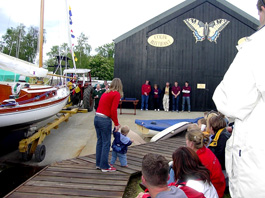
|
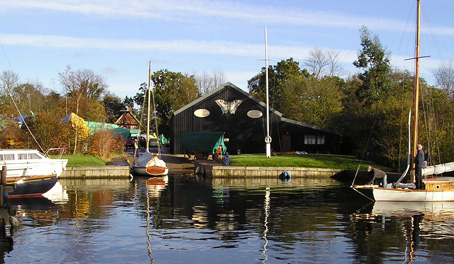
|
The team that arrived in Ludham
consisted of Colin Buttifant and his wife Wendy,
who was responsible for the administration, along
with Ian Yaxley and David Burton. Paul Buttifant,
his son, joined them as soon as the yard opened.
This core team has been responsible for the
day-to-day operation since that time.
When Colin lived in Upton he started doing odd
jobs for a local farmer. He was then given the
chance to convert some old farm premises into a
workshop in Upton. That was when his business
began to grow and develop. It took him about two
years to get the workshops set up whilst doing
lots of small jobs around the village of Upton. |
Colin, once established, had the notion of building a
sailing boat, and with the help of Paul Reynolds, who was
a carver designer, drew up plans for the little boat
called the ‘Bure Classic’. He tried to sell from the
drawings but had no takers, so eventually he decided to
build it. He decided to give it a glass fibre hull but
with wooden top-superstructure, the idea was to make it
like a 1930’s Broads sailing craft. At this time the
business was growing fast and everything was getting
crowded in the workshops. He used to get anything from
thirty to forty boats to work on and he had to track these
all through the village of Upton so he really needed
somewhere else for the business. He wanted to be on the
river but everything that came up for sale at that time
was turned into housing. One day he stumbled upon the site
in Horsefen Road in Ludham and he could not believe his
luck when he eventually managed to buy it. It was a big
achievement.
As all this was happening he was
building the little ‘Bure Classic’ and after
getting planning permission for the Swallowtail
Yard, and the basin had been dug, he moored her in
the basin even though they had not relocated from
Upton. It was turned into a holiday boat so that
it would be seen out on the water and after about
two months they had actually sold two new ones.
The business won the best Restoration prize at the
1992 Windermere Classic Boat Festival for a little
launch called ‘Barn Owl’. She had originally been
built in the 1900’s and was restored at
Swallowtail Boatyard in 1991/2.
Today they are a family business run by Colin, his
wife Wendy and his son Paul with a small team of
dedicated craftsmen who produce quality work. They
undertake repairs and restoration work for both
motor and sailing craft and they build-to-order
their ‘Bure Classic’ and ‘Womack Classic’ yachts.
They also do some bespoke building and have a hire
fleet of ‘Bure Classics’ and one ‘Womack Classic’.
They have an extensive range of paints and
fittings and specialised items can be ordered
through them. Hard and soft wood can be supplied
and cut to specific requirements. Sheet materials
from plastic laminates to marine grade plywood are
also available. They make masts, spars and
specialised mouldings to order. |
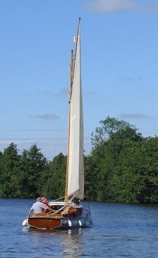
|
As the boatyard developed, the central theme was to show
quality in every respect. The yard has been landscaped and
now provides an attractive setting for the business, the
hirers and the customers, as well as for river-users and
passers-by on Horsefen Road.
The Steam Electric Launch Company
In 1993 the Steam Electric Launch Company were building
replicas of launches based on late Victorian designs for
use on the River Thames in the old foundry premises on
Norwich Road, next to St. Catherine’s Church. The company,
owned by Robert Latham, produced Glass Reinforced Plastic
(G.R.P.) hulls with Mahogany and Teak topsides. Two
fifty-foot launches were built in 1993 for use by
officials at Henley Regatta.
Bibliography
Journal of the Norfolk Wherry Trust, Fiftieth Anniversary
Issue, Spring 1999.
Transcript of Audio Tape with Colin and Wendy Buttifant
Malster, Robert., Wherries and Waterways, Terence Dalton
Ltd., 1971.
Eastern Daily Press, January 19th 1974
Eastern Daily Press, May 7th 1993
Johnstone-Bryden, Richard, Hunter’s Fleet, Nighthawk
Publishing, Halesworth, Suffolk
Transcript of Audio Tape with Christine Taylor (2004),
Ludham Archive Group
|
|
|













